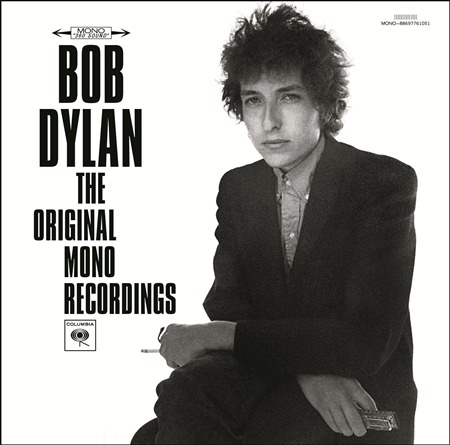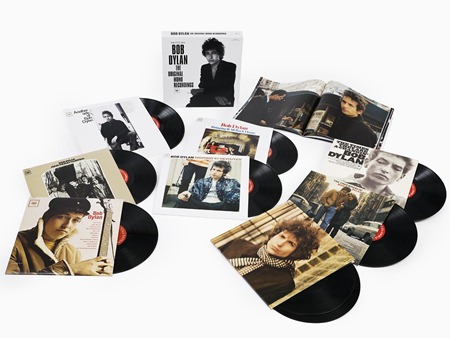 Bob Dylan: The Original Mono Recordings (Columbia)
Bob Dylan: The Original Mono Recordings (Columbia)
Originally released in 2010 and still available (even on CD), this box contains Bob Dylan’s first eight albums in mono. The sleeves are absolutely wonderfully accurate reprints, even including the original inner sleeves and the drawing that came with the first copies of “Highway 61 Revisited”.
Please Support Pattaya Mail
The albums are housed in a cardboard slipcase box which includes an album sized book in soft cover.
The records are pressed on high quality 180 gram vinyl. You should actually prefer these mixes for the more common stereo ones as most artists focused on mono in the 60’s, and that includes Bob Dylan. If you want to know what sound Dylan had in his head when he made these albums, look no further. Here’s what you get:
Bob Dylan (1962)
Chubby dude with cap, guitar and old eyes (cover image remains inverted after 52 years). The young Dylan (21) lets his coyote-howl and biting gravel voice loose on selected works by his idols, accompanied by driving rhythmic guitar and piercing harmonica. He is hungry and restless and grumpy as an old-timer with a shotgun. He tips his cap respectfully to Woody Guthrie, while delivering ammunition to The Animals’ first two singles (“Baby, Let Me Follow You Down” and “House Of The Rising Sun”).

A bit dated, but still fascinating, and sounds so much better in mono.
Key tracks apart from the aforementioned: “Song To Woody”, “Talkin’New York”.
The Freewheelin’ Bob Dylan (1963)
12 of the 13 songs are written by Dylan. A giant leap from his debut. And he sings them with less ferocity and more deliberate resentment, that rasping, leathery voice was the soundtrack to the anti-nuclear and civil rights movements that flared up across the United States. Crass attacks on those in power, the warmongers and the racists, galvanizing sing-alongs with a sharp social conscience, and on top of all that his beautiful, painfully honest love songs. A masterpiece. Sounds awesome in mono.
Key tracks: “Blowin’ In The Wind”, “A Hard Rain’s A-Gonna Fall”, “Masters Of war”, “Girl From The North Country”, “Don’t Think Twice, It’s All Right”.
The Times They Are A-Changing (1964)
The performance is even better, and the attachment, the “11 outlined epitaphs” a great pre, but still this album is a very predictable sequel. Biblical themes appear in the title track and “When The Ship Comes In”. The album’s gem is “One Too Many Mornings”, a magnificent visionary representation of a crumbly love affair. The album characteristically ends with “Restless Farewell”. “The Times…” was Dylan’s last protest LP.
Key tracks apart from the aforementioned and the title track: “With God On Our Side”, “The Lonesome Death Of Hattie Carroll”, “Ballad Of Hollis Brown”.
Another Side Of Bob Dylan (1964)
Completely different songs about quite some other things. Conceived within a few days and a case of wine. The visionary is freed. The enemy is not necessarily among his political opponents, but just as much among his own followers (it’s not me you’re looking for, babe).
The gospel according to Dylan has from here on out always been developed from the basic concepts of “freedom” and “individualism”, mixed with lethal doses of satire and some hilarious outbursts of humour. With this album Dylan steps out into the open. The only thing missing was a band.
Key tracks: “All I Really Want To Do”, “Chimes Of Freedom”, “My Back Pages”, “It Ain’t Me Babe”.
Bringing It All Back Home (1965)
One side electric rock, one side acoustic songs (with a strumming electric guitar added). Dylan lost many “friends” but won the world. Single handedly he put an end to the British invasion and brought rock back home. Bringing it all back home indeed!
The electric songs are somewhat scrawny and lack punch – although the mono mixes make up for some of that. The prancing, staccato “Subterranean Blues” is a classic (its one-liners are a T-shirt manufacturer’s wet dream). The four final songs have all retained their visionary power, especially “Mr. Tambourine Man”.
Key tracks apart from the aforementioned: “She Belongs To Me”, “It’s All Over Now, Baby Blue”, “Gates Of Eden”, “It’s All Right Ma (I’m Only Bleeding)”.
Highway 61 Revisited (1965)
It is impossible to write a review of the Bible. “Highway 61 Revisited” eludes all measurements because it is the benchmark of all things. Perhaps the most perfect album of rock. No one else could have written these lyrics. No one else could have created this sound.
From the first drum gun shots that heralds “Like A Rolling Stone” to the ethereal beautiful closing epic “Desolation Row”, this is a trip. Magic. Timeless. Listening to it in mono is actually enriching. Even if the stereo version is wonderful, you simply have to hear this.
Key tracks apart from the aforementioned: “Ballad Of A Thin Man”, “Just Like Tom Thumb’s Blues”, “Queen Jane Approximately”.
Blonde On Blonde (1966)
The Bible, the sequel. Arrangements are slightly more sophisticated (Nashville’s finest), but the lyrics and the way Dylan sings them tells a different story. His very existence is on the line, walls collapse, ground cracks and everything is on fire.
Over four record sides Dylan delivers what on the surface sounds like love in pain, but in all its visual richness and fiery imagery is so much more. Dylan has burned his candle at both ends, he is worn, frayed, torn, and so drugged out he hardly knows where he is. In the summer of 1966 he disappears. The break probably saves Dylan’s life.
Key tracks: “Visions Of Johanna”, “Stuck Inside Of Mobile With The Memphis Blues Again”, “Just Like A Woman”, “I Want You”, “Sad Eyed Lady Of The Lowlands”.
John Wesley Harding (1967)
When he finally returned (from the noisy city), he did it gently (to the wooden hills of Woodstcok). His voice had turned into an unfamiliar clear tenor. Some of the lyrics were humble and in wonder, religious like, but with an admonitory and moralizing undertone. A few Kafka references are thrown in for good measure (“Drifter’s Escape” is clearly influenced by “The Trial”: the Trial was bad enough, but this is ten times worse…).
The extremes are represented by the apocalyptic and irresistibly hypnotic “All Along The Watchtower” (one of Dylan’s most economical and frightening lyrics) and the sweet country-ballad “I’ll Be Your Baby Tonight” (which closes the album and points towards the next).
Key tracks apart from the aforementioned: “As I Went Out One Morning”, “Dear Landlord”, “I Dreamed I Saw St. Augustine”.
 |
 |
 |





